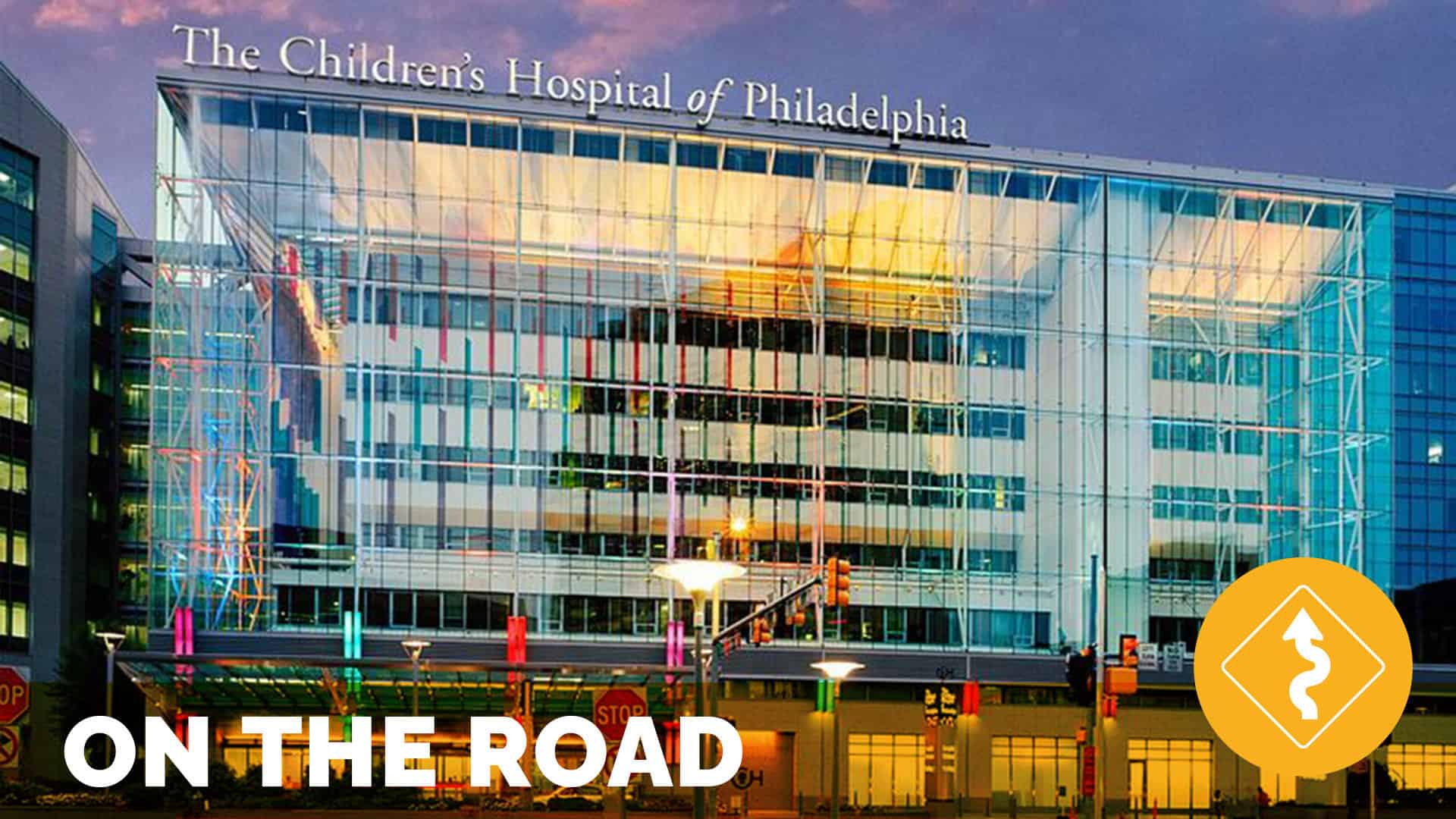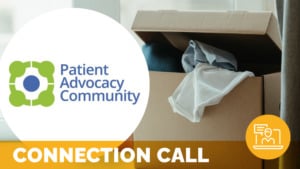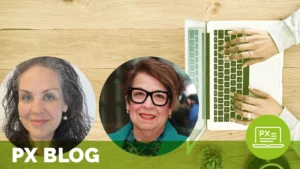A Foundation of Hope: Engaging All Voices in Achieving Experience Excellence

On the Road with Children’s Hospital of Philadelphia – January 2017
by Michelle Garrison and Jason Wolf
Our latest On the Road took us to Children’s Hospital of Philadelphia (CHOP). The opportunity to visit pediatric facilities and children’s hospitals has always been exciting and significant. This is represented in the very essence of the work they do and reflected in how so many of these organizations get the true comprehensive nature of experience. That is, that it requires the engagement of all, not just patients, but families and the team that delivers and supports the delivery of care, to achieve the best in outcome.
Our hosts for our visit, Rachel Biblow, Senior Director of Patient and Family Services and Anne Marie Richards, Patient and Family Services Program Coordinator, were excited to take us on a comprehensive tour that included not only the main campus but also The Buerger Center for Advanced Pediatric Care, a newly opened ambulatory care center. It was clear from the start the level of excitement they had in having a chance to showcase the work they are doing and the advancements they are making at the bedside.
The inclusion of the patient and family member perspective was evident as we visited throughout the hospital and especially in the ambulatory care center. Through the Family Advisory Councils (FAC) and a Patient/Family Partners Program, CHOP gives family members opportunities to volunteer, provide feedback and give back to the organization. With the partners in particular, the organization doesn’t have to wait for monthly FAC meetings. They can receive instant access to patient and family member feedback. As Anne Marie shared, the program is helping us “always ensure the family voice is included in the work we do and what would we be without that experience. You need all of those perspectives.”
The Active Voices of Patients and Families
For this reason, in a place that declares, “Hope Lives Here”, it was not surprising that our visit began in a unique way. Our first encounter was the chance to attend CHOP’s Family Advisory Council meeting. This opportunity to listen and learn firsthand and to set the tone for the rest of our time. It underlined the organization’s clear and purposeful commitment to acknowledging and empowering patient and family voice in the all the work they do and reinforcing the critical element of partnership needed to succeed in healthcare today.
What was intriguing about the FAC session was that it reached beyond the traditional discussions we have seen FACs tackle in providing operational and process input to getting into some of the actual work taking place at CHOP in research and sciences. FAC members were asked to provide input on studies that were being formulated and asked about ways in which best to engage and involve family in these efforts. The group Co-Chaired by Family Consultant, Darlene Barkman, was thoughtful, active and seemingly energized by the opportunity they had to part of the design of efforts, not simply react to work already being done. This sense of incorporating the patient and family voice prior to, versus after taking action, set the stage for our tour and formal visit to the facility the next day.
Designing with Purpose
This idea of engaging voices in design was immediately present in what was a highlight of our visit, a tour of the new Buerger Center for Advanced Pediatric Care. The center features clinical neighborhoods that group related specialties together, often on the same floor, allowing for a design that makes it easy for patients and family members to navigate from one care area to another and manage their office visits. Family consultants, clinicians and a range of disciplines were consulted throughout the design process and asked to share not only the type of environment they would like to see, but how that physical environment could truly support a more effective care process overall.
Family members involved their children and shared clear ideas on how to make care accessible to children in a way that was also safe, engaging, comfortable, accessible and even understandable. Rachel shared that “we believe we are better when we work together and this approach allowed us to build something that is truly remarkable.”
The Buerger Center is an extraordinary space to visit. Each floor of the building features different theme with colorful photos around a central focus around kids in motion. Throughout the building, we found “Wait, Play and Learn” areas that were designed to fit not only the children’s needs but also the family’s needs.
Pat Richards, Senior Director, Ambulatory Services, Main Campus, was an integral part of the design process and spoke of how providing these “Wait, Play and Learn” areas was important to everyone involved. She shared how they once again looked at opportunities to engage with and bring in the patient and family member perspective.
The careful selection of colors, the integration of play spaces that featured motion-activated and hands-free games that showed a focus on infection control and the quiet areas that recognized that a quiet place may be an option people seek, reinforced the voices that patients and family members brought to the design process. We couldn’t resist trying out the motion-activated areas that would cause lights to come in on in a brilliant display or activate a toy to start running.
Of interest was not only the design elements, but the thoughtful and high tech process flows built into the facility as well. From easy admissions kiosks to patient and provider tracking mechanisms the building and its clinic space was designed for an effective and efficient flow. The smaller details were also relevant as well, for example moveable desks were placed in the exam rooms versus static tables so clinicians could position themselves facing patients and family members while still documenting information.
Amy Kratchman, one of the Family Consultants, shared with us how involved she and the Family Partners were in the process. Amy’s son, now an adult, has been treated at CHOP for autism since he was 15 months old, and she was involved in the design process from the beginning. She commented: “They asked the Family Partners what we wanted instead of just thinking they knew what we wanted. We saw blueprints and helped identify how some spaces weren’t quite right for children experiencing development issues. From selecting decorations to noise control, we played a part.“
Our next stop in the building was the roof top garden where we braved the chilly temperatures and stepped out into another carefully thought out area designed to engage patients and family members as well as provide a respite from the world of clinical care. In this space, we not only found quiet areas designed for meditation but also paths, purposefully designed to represent the different types of terrain one might encounter outside the facility, to help patients learn to navigate with devices or wheelchairs. It was not only a fun and calming environment, it was a thoughtful and safe environment in which to build awareness and confidence.
Normalizing the Experience
As we met and learned about the work that is taking place, one of the central themes that kept being repeated when speaking with everyone is how they are focused on finding ways to normalize the experience for not only the patients, but also the family members.
In the Connelly Center, a space the provides laundry facilities, sleep rooms, computers and a library where family members can check out books, videos and games for themselves and their child we met Prentice Beckett, Family Relations Supervisor. He proudly showed us a space where family members can come in and take a moment to catch their breath. He shared how the Center is also oftentimes “a beginning place for families to get started on their journey where their new reality is managing a chronically ill child.”
We also met with Elise Keels, Child Life Specialist, Kate Lannan, Oncology Social Worker, and Caitlin Mulligan, Patient Resource Navigator, who shared with us some of the programs that play a role in educating patients and family members as well as Linda Kocent, Manager of Patient and Family Education, in the Family Learning Center.
The Social Work and Child Life Programs provide education for the patients and the family members including siblings. They are taught in a way that is easy for kids to understand. Elise told us, “we want to provide them with education and tools to help them build coping skills and to help them manage the routine parts of their treatments. Our goal is to normalize the experience not only for the patient but for the family member as well.” Kate also commented on how “the level of buy in from the family when they are comfortable makes it is easier for us to provide care.”
One highlight was seeing Elise bring a pack of cars to a small boy waiting for treatment and watch him eagerly tear into them and begin to play. They are providing spaces and opportunities for kids to be kids and not just a patient. At that moment, he was just a boy who was excited for a new toy and not a cancer patient awaiting his next outpatient procedure.
We also had the opportunity to see very thoughtful education opportunities offered in the Family Learning Center where family members are given the chance to train on how to navigate healthcare situations they might face with their kids once home. In the learning center, parents get to learn by doing with the actual equipment they will be using with their own children. Their intent is to help make situations less scary and daunting and provide a sense of safety for these family members who are facing difficult and challenging situations. As Linda shared, ‘we are giving family members a chance to take the skills back to the bedside. We are empowering the family in their child’s care.”
Part of this process is also ensuring feedback is heard, acknowledged and addressed. We had the chance to meet with Martha Thomas, Manager of Patient and Family Relations who reinforced a central point. “The voices of those we care for and serve matter. But beyond that we cannot just listen, we must act.” Critical to improvement, Martha shared, was triangulating the data you have to identify and tackle any issues the organization may be struggling with. Her role is to hear people and as she added, “I tell people they can yell. It’s okay to let it out and then work with me to help them get their concerns addressed”. In hearing these voices CHOP is providing a means to identify opportunities for improvement and engage all those involved. Martha offered, “We have to hear not just from families, but the children themselves.” This reinforces a commitment we saw at CHOP not only to address the whole issue, but to treat the whole person.
Treating and Supporting the Whole Person – Patient, Family and Staff
Throughout our visit, we were introduced to programs that CHOP is implementing to support not only their patients and family members but also the staff. One program being implemented focuses on integrative health practices. As they continue to expand application of new ideas and develop a stronger evidence base for practice, the group, led by Dr. Maria Mascarenhas’s, Medical Director, Integrative Health Program looks to become a premier provider of holistic health and an evidence based center of excellence. This is important to CHOP because they believe, as Dr. Mascarenhas shared, “Healing is more than taking care of the disease.”
To gain better understanding and strengthen buy-in and application of these new methods, the team, started with a focus on the CHOP staff and is working to build a network of champions who will advocate for these additional methodologies of care from mindfulness work to massage and including acupuncture, yoga and more. The team is looking to expand treatment opportunities and strengthen wellness for staff as well.
Greg Hedler, Oncology Social Worker, who has lead several yoga workshops spoke of how they now have over 300 staff members who are currently interested in yoga and attending classes. Having the staff experience the classes provides an opportunity for them to then introduce these opportunities to their patients and family members.
One great example of these services is yoga, where they are seeing patients become more aware and in touch with their own bodies. This is particularly important for children so they can learn and understand different types of pain they are experiencing so they can better relay this to their care team. One example, Greg shared, is how it can help a young child understand the difference between hunger pangs and more serious stomach pain. Yoga gives them to a connection to their body, and they are seeing a decrease in the amount on pain medication patients request.
Yoga has also helped parents connect with their children. Greg told us of a how in one yoga class there was a parent who had paraplegic child, and they were going through the yoga poses. She said she would have never thought to take her out of the chair this way. It provided an opportunity for engagement not only with the family member and the staff but also with the parent and child. It helped the mom see her daughter’s strength and look at another way they could connect.
Another area where we saw the focus on treating the whole person was through an extensive commitment to spiritual care services. In the pediatric environment, the fragility of life is amplified through the journey of these child patients at the same time raises the emotional elements at play for all who support and care for them. In this case, specifically in dealing with the spiritual aspects of our human, CHOP designed a space with a purpose and with the family member perspective. Like many other chapels we have seen, it provides a quiet, reflective space for patients and family members to go. Gabi Jenicek, Manager of Spiritual Care and Language Services, showed us their “God Box,” an idea that came from a beloved Chaplain, Sr. Alice Strogen, who attended a play, called, “The God Box.” The play written and performed by Mary Lou Quinlan resonated deeply with their Chaplain and inspired her to create a way to bring it to CHOP. In partnership with the Family Advisory Council, the Spiritual Care team created an opportunity for people to place a message, a thought or prayer in the box which symbolizes letting it go which can help provide a sense of peace and closure and allow them then to take that with them and then return to their family member. Gabi shared with us they now have six full time chaplains providing 24/7 coverage. These staff members are often present with the family at the worst time in a parent’s life. They provide support not only for patients and family members but also support and care for colleagues. The chapel also provide a safe environment for staff to come together to deal with tragic events they may experience.
Support of patients, family members and staff is a clear focus and was evidenced when we spoke with Dr. Linda Hawkins, Family Services Specialist. Linda focuses on supporting the LGBT population and providing education and staff training. Linda shared statistics regarding LGBT families in that “29% of LGBT families and 74% of transgender families say they don’t feel comfortable sharing their family situation and believe that if they do, they will receive poor treatment.” For Linda, this is summed up by a simple question she heard from a parent – “will you love my child?”
There is a mindfulness behind providing a safe environment, starting with staff and then bringing in patients and family members. Linda shared her thoughts around this, “We want to provide a safe environment for our staff where they are respected which makes for a more positive work environment. When staff members feel safe to be true to themselves this translates to the patient and family members as well. Our staff has shared that when we get to be our whole self, it’s huge and our patients get to be themselves.”
There is a clear importance in providing an environment where patients and family members can feel comfortable in seeking treatment and be respected while remaining true to their personal lives. A simple but profound thought from Linda is that “this is work that saves lives.”
Experience Excellence Grounded in Culture
Like so many other experience efforts, the achievement of results and the adaptation of practices takes time and CHOP believes they are no exception. At the same time, their commitment is palpable, their achievement measurable and in fact they recognize that have more work to do, a central characteristic we see in higher performing organizations. That is an acknowledgement that there will also be work to do and not a “there”, at which you ever truly arrive. CHOP’s Patient Experience Team and senior leaders shared how their journey started first with a recognized need to implement a culture change across the organization. Central to this was the realization that the patient experience encompasses everyone’s experience including their staff.
The team at CHOP worked through an extensive exercise to identify both shared values and a clear and simple set of service standards they could understand, be guided by and act on. That last part perhaps was the most critical, in ensuring values are actionable, rather than passive declarations. This shift in thinking about doing is a fundamental way in which to engage and reinforce accountability overall. To move their cultural transition forward, the trained leaders and staff and now incorporate these standards in both current staff’s performance evaluations and use they a part of the interview process for new team member as well.
Jackie Noll, Senior Director of Nursing offered, “We are a people business. We are more than brick and mortar, glass and steel. So, we must make this process transparent and understood by all in all we do. If our staff feels like they are in it together the results will follow. This idea was apparent in almost every encounter we observed between and with members of the CHOP team. From seeing how registration clerks greeted patients with a smile or how nurses met their patients and families in waiting rooms, engaging them as people, explaining plans and answering questions, to the small things such as delivering a new car to a waiting cancer patient or helping someone find their way between buildings, there was a general sense of connection, commitment and pride that permeated CHOP altogether.
Hope Lives Here
In a pediatric facility, you are privileged to see some of the bravest people, not the clinicians or support teams, but these young patients who all too often are forced to be wise beyond their years. Yet in the face of struggle you always find a warm and smile, laugh and hope of all that can be done. In this and other places, perhaps youth is not at all wasted on the young. Rather it is nourished by an organization that believe hope guides its cause. An organization that designs itself with those that use it. An organization that acknowledges it is only as effective and success as its people are healthy and engaged. The team at CHOP are working every day to achieve this intricate balancing that experience calls on us to maintain.
As we wrapped up our visit we asked Rachel and Anne Marie to share some final thoughts. Anne Marie noted that the team at CHOP prides themselves on the work they do, not just the outcomes they achieve, but the way people feel and are treated as they travel their CHOP journey. Rachel added, “It’s hard not to walk into a place like this and not know why you are here. We have an obligation to be our best each and every day. Families are trusting us to take care of their children. At the end, though, we cannot forget that we still provide an environment where they get to be kids.”
It is that powerful balance that reflects the pediatric world that continues to inspire the commitment, focus and actions of the team at CHOP. What they shared with us over our visit only scratched the surface of all we know they do in this respected Institution. Yet, the purpose with which they tackle their work, the support they provide one another and the care they deliver each day is unwavering and serves as what can be possible is we bring a little hope to life each day.
Related content
-
 Environment & Hospitality | Staff & Provider Engagement
Environment & Hospitality | Staff & Provider EngagementLost Belongings Workgroup (November 15, 2023)
1pm ET / 12pm CT / 11am MT / 10am PT –The Lost Belongings Workgroup is a meeting space for those interested in conversations and solution generation with patient advocates working to improve lost belongings policies and practices.
Learn more -
 Environment & Hospitality
Environment & HospitalityMaximizing the Wait: 4 Ways to Transform Lost Time in Medical Facilities into Patient Engagement
By Lauren K. Janney, Co-Founder/Chief People Officer at CXPerks For most patients, the waiting room experience in a medical facility is synonymous with frustration. Whether it’s a routine check-up or an emergency visit, the wait time often feels like lost time—an unavoidable delay in an already stressful situation. It is suggested that nearly 20%
Learn more -
 Environment & Hospitality
Environment & HospitalityThe CROWN Project: Promoting Haircare Equity in Hospitals
By: Amanda Pitt, MBA, BSN, RN, MEDSURG-BC, NEA-BC Nursing Operations Specialist and Nurse to Nurse Mentoring Program Administrator Parkland Health | Parkland Center for Nursing Excellence Marygrace Hernandez-Leveille, PhD, APRN, ACNP-BC Nurse Scientist Parkland Health | Parkland Center for Nursing Excellence Introduction Imagine being in the hospital for an extended stay and not having the right
Learn more
